Featured Application
The bioelectric technology in this study shows high efficacy for the removal of total biofilm, as well as viable reduction in cell density, through testing of the HVAC evaporator. We anticipate that this could be a foundation for developing a new HVAC hygiene control system.
Abstract
Biofilms comprise diverse bacteria and fungi with slime material, especially in humid conditions. The surface of the heat ventilation and air conditioning (HVAC) system, especially at the evaporator, is in high moisture conditions due to the compression and relaxation of refrigerant. Biofilms comprise electrically polarized molecules, which include polysaccharide, DNA, liposome, and diverse amino acids. Thus, when an electric field is applied to biofilms, the field creates an electrostatic force that enhances the destruction of biofilms and results in detachment from the surface. The principles are known as the bioelectric effect. A new bioelectric (BE) technology has been developed that is focused on the optimization of electrical energy for biofilm removal, and its efficacy has been previously demonstrated. In this work, a prototype of the BE device for HVAC application has been fabricated and tested. Escherichia coli (E. coli) biofilms were utilized as a standard model of biofilm on the HVAC evaporator. The results demonstrate that when the BE technology was applied for one hour, approximately 81.8% of total biofilm was removed. Furthermore, live cells in biofilms were reduced by approximately 71.4% under the BE device, compared to non-treated biofilms.
1. Introduction
As well-being healthcare for the quality of life has become critical, environmental hygiene control of vehicles has become of great interest. Considering that the space of the car is typically limited, inadequate air conditioning could result in high risk of respiratory disease [1]. The root cause of internal air contamination in automobiles, especially the evaporator part of the heat, ventilation, and air conditioning (HVAC) system, is the growth of the multispecies group bacteria with an extracellular matrix that are defined as slime biofilms [2,3]. The evaporator includes the compression and expansion of refrigerant that results in relatively high humidity, providing favorable conditions for biofilm growth [4]. According to the literature, when the automobile reaches approximately 50,000 km cumulative driving distance, biofilms could be established on the surface of the evaporator, resulting in a bad smell of the HVAC system [5,6]. Furthermore, the cleaning of biofilm includes entire disassembly of the main part of the car, and requires physical brushing, as well as chemical detergent, which are inconvenient and labor-intensive procedures.
The purpose of this study was to develop a new evaporator biofilm management system with ultra-low electric power consumption for reducing biofilm growth. The system integrates bioelectric (BE) technology that characterizes high efficacy of biofilm removal with below 0.7 V of electricity [7,8].
For HVAC applications, a modular device that is integrated with the commercialized evaporator was designed based on numerical analysis and successfully fabricated. The system was tested with standard biofilm growth procedures and the efficacy investigated through total biofilm quantification, as well as viable cell counting methods.
2. Materials and Methods
2.1. Design of the Prototype System
Numerical analysis of the electric field optimization for the developed system was performed. The distance and shape of the electrode were designed and simulated according to the experimental setup. The electrode size was 3 mm × 10 mm in height and width, and the spacing of each electrode was designed to be 6 mm. The end of the electrode was of a round shape, and the material was defined as stainless steel. Electrically conductive material is essential for providing an effective microcurrent, with most metals showing conductivity in a range of 106 S/m. We have chosen stainless steel with 1.45 × 106 S/m. The alternating current (AC) conduction module was used to analyze the electric field. Two voltage conditions were applied, 0.7 and 5.0 V, respectively, at 10 MHz, based on previous work [8,9]. The media condition was assumed to be water, corresponding to the experiments.
The electronic part includes an electric circuit that generates a specific frequency of AC signal with direct current (DC) offset. A 10 MHz crystal oscillator was applied for precision AC supply, and the DC was realized using resistors and capacitors (Figure 1). Since this circuit consists of passive components, the total electric power consumption was minimized in the 1 mW range, enabling battery-operated electronics. The electric circuit was integrated into a 1.44 cm2 footprint.
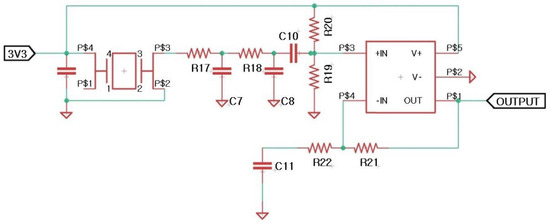
Figure 1.
Circuit diagram of the electronics.
To investigate the spatial distribution of the electric field in the testing package, numerical analysis (Ansys Inc., Canonsburg, PA, USA) that focused on the relative magnitude of the field generated between the electrodes was performed as the electric potential was changed from 0.7 to 5.0 V.
2.2. Experiment for the Total Biomass on the Biofilm Using BE Treatment
For the total biomass of the biofilm experiment with fluorescence microscopy measurement, the automotive evaporator core structures were mimicked by multiple layers of thin aluminum plate. Twenty-eight layers of thin aluminum plates of 27.0 mm × 6.0 mm × 0.05 mm (height × width × thickness) were placed at intervals of 0.81 mm between two plate walls (Figure 2a). The aluminum plate block was embedded in a small chamber for biofilm growth (Figure 2b).

Figure 2.
(a) Schematic of the total biomass test: structural components mimicked an automotive evaporator core. (b) Photo of the testing setup. (c) Photo of the total biomass test after 48 h of biofilm growth.
The biofilm was established in a growth media (LB media, Life Technologies Inc., Carlsbad, CA, USA) for approximately 48 h to provide sufficient time for maturation (Figure 2c). Six of the thin plates from the testing setup were randomly chosen and stained by a fluorescence dye (Alexa Fluor 647 Ester, Thermo Fisher Scientific Inc., Waltham, MA, USA) as the initial condition. The BE technology was applied to another six thin plates for one hour at the electrodes of the package following the fluorescence microscopy measurement. The electronics generated 0.7 V amplitude of sinusoidal signal at 10 MHz with 0.7 V of offset.
The total biomass analysis was performed by a fluorescence staining method with microscopy image measurement (IX83, Olympus fluorescence microscopy) and was calculated using the standard software for the analysis (ImageJ 1.44, NIH, Bethesda, MD, USA) [10,11]. The percentage of surface coverage corresponds to the total biomass [12].
2.3. Experiment for the Density Analysis of Live Bacteria on the Biofilm Using BE Treatment
An evaporator block was obtained from an automotive part (Elantra, Ulsan, Hyundai Motors, Republic of Korea), and a piece of the block of 7.0 cm × 6 cm × 4.5 cm (length × width × height) was prepared for the biofilm growth testing, as shown in Figure 3a,b. A housing package was fabricated for the electric field application to the surface of the evaporator. Based on the design analysis, a testing package was developed. The package included: (1) aluminum electrodes for the electric field supply, (2) a polypropylene housing case for the mechanical structure fabricated via 3D printing, and (3) an external electric circuit for the electric field generation, as shown in Figure 3a.

Figure 3.
(a) Schematic of the testing package and photo of the biofilm growth testing setup and the power supply, (b) a real evaporator block taken from a new automotive part for biofilm growth testing (7 cm × 6 cm × 4.5 cm, Elantra, Hyundai Motors Korea), (c) signal from the electronics for biofilm reduction.
The electronics generated 0.7 V amplitude of sinusoidal signal at 10 MHz with 0.7 V of offset (Figure 3c). The seven aluminum electrodes with 1.5 mm width were placed at intervals of 6 mm on each side of the package of electric field application.
The five packages were tested in biofilm growth media as per the details of the procedure presented in the literature (control: n = 1, BE-treated: n = 4) [1,8,9]. The biofilm was established in a growth media (LB media, Life Technologies Inc., Carlsbad, CA, USA) for approximately 48 h to provide sufficient time for maturation. The quantitative analysis of the result included total biomass reduction, as well as the density of live bacteria of the biofilm. Live cell density was quantified using the standard colony forming unit (CFU) assay [13] (Table 1).

Table 1.
Summary of the testing package and analysis method.
3. Results
Between the two electrodes, the magnitude of the electromagnetic field along the length of the vertical axis gradually increases toward the center, maintains about 6 mm at the maximum value, and then gradually decreases (Figure 4). Based on this analysis, we designed the distance between two electrodes to be 6 mm to ensure the electric field application. Since the density of electricity would be amplified at the corner of the electrode, the electric field could be non-uniform in between the two parallel electrodes (Figure 5). Uniformity of the electric field could affect the biofilm reduction efficacy based on the principles of the electrostatic force spatial variance that might decrease the net force on biofilms. Hence, we did not expose the corner of the electrode to the media, as the electrode was placed inside the polypropylene package with 0.7 V of electric potential application (Figure 5).
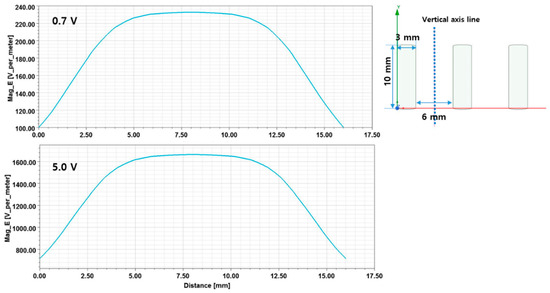
Figure 4.
Plot of the magnitude of the electric field along the length of the vertical axis for the different voltage conditions.
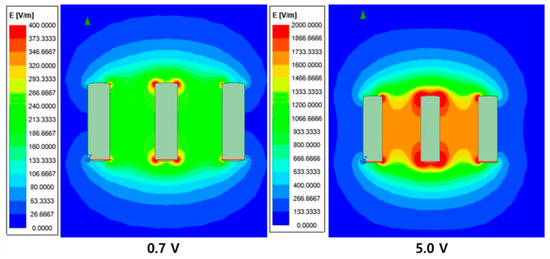
Figure 5.
Contour plot of the estimated value of the electric field for the different voltage conditions.
The percentage of surface biofilm was calculated as the green fluorescence image was converted to the binary (black and white, in Figure 6), based on the intensity of the green fluorescence wavelength. Figure 6 shows that when the electric field was applied, dramatic biofilm reduction was demonstrated. Overall, six images of each condition were analyzed, and the average surface coverage of biofilm with standard deviation showed significant reduction of total biofilm (Figure 7). The average value reduced approximately 81.8%, compared to the non-treated biofilms (Table 2). Since the biofilms were grown for 48 h, it is assumed to be a well-established biofilm; the results demonstrate that when the BE was applied for one hour for the matured biofilm, the electric treatment removed a significant amount of biofilm.
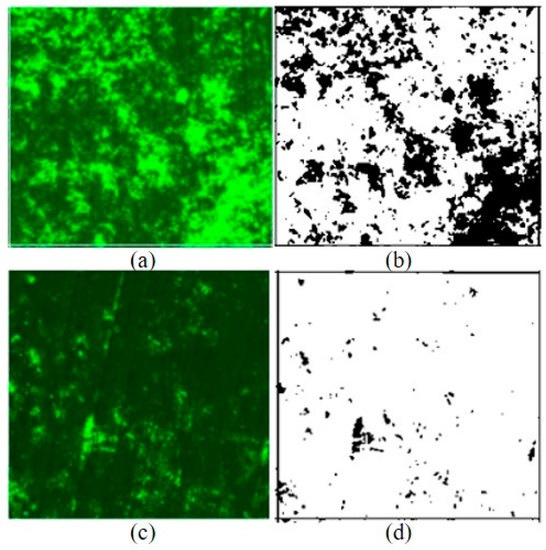
Figure 6.
Representative images of biofilms. (a) Green fluorescence control biofilm, (b) binary converted control image (black area corresponds to the biofilms), (c) after one hour electric-field-treated green fluorescence image, and (d) binary converted one hour electric-field-treated image (black area corresponds to the biofilms).
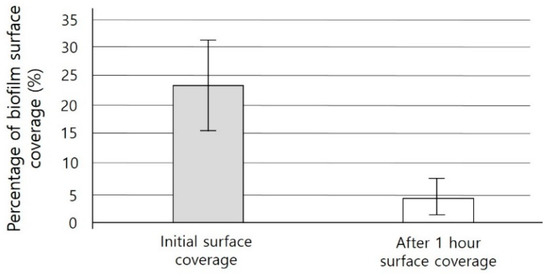
Figure 7.
Percentage of the surface biofilms between control (initial) and BE treated (after 1 h) images (n = 6).

Table 2.
Surface coverage of biofilms in control and BE-treated (after 1 h) images.
Since the biofilm growth could be established within 24 h, the biocidal effect is critical, especially when focusing on its prevention capability. In addition to the total biomass quantification, biocidal efficacy was investigated using the colony form unit assay. Table 3 shows that the viable cell after a 1 h treatment of the BE technology has been significantly reduced, 71.7%, in contrast to the control (non-BE in growth media), for which the population increased 4.8%.

Table 3.
Viable cell reduction of biofilms between control (initial) and BE-treated images (the electric field decrease in live cell in biofilms).
4. Discussion
As the results demonstrate for both total biomass and viable cells in the biofilms, BE technology can be an alternative method for biofilm management. The details of the electrical treatment mechanism are still under investigation; however, many hypotheses are suggested that it could induce the molecular vibration of biofilms under alternating electric field application [13], generate surface electrostatic force of the direct current, and induce non-uniformity of the local electrolyte, which are essential to the activation of enzymes [14]. The induced biochemical condition with electrostatic force could make biofilms detach from the surface [15]. Based on the principles of BE technology, the results also show that the electric field application to the biofilms demonstrates significant reduction of the total biomass, as well as increase in the biocidal effect.
In the total biofilm quantification testing, one of the testing conditions has been shown to lessen biofilm formation as well as reduction of it (#5 condition of Table 2). This is due to the biofilm formation not being consistent with the same conditions. The growth of biofilm can be varied in nature since the DNA expression, transcription, and amino acid formation may be affected even in minor variance of conditions [12,16]. For further investigation, we plan to control the condition tightly using a microfluidic system or testing in a humidity- and temperature-controlled system. Even if the testing result showed variance of biofilm growth and reduction, it demonstrated with statistical significance that the microcurrent applied system could be effective for biofilm contamination management.
The total electric power consumption of the prototype system is less than 1 mW, which can be provided by a commercially available battery, typically with electric capacity of 300–2000 mA current with −1.5–9.0 V. This low power utilization biofilm inhibition system has significant advantage for portable and electrically isolated system development, including the electric automotive industry and home appliances. In particular, in this work, we performed biofilm inhibition testing experiments using a commercialized evaporator that could make a foundation for resolving biofilm contamination issues in the automotive system.
Future studies with the current system will be conducted to improve the reduction efficiency of biofilms on the automotive evaporator by using high conductivity material and optimizing arrangement of electrodes.
We believe that the ultra-low power consumption system demonstration might be integrated for electric vehicle HVAC system hygiene management that needs to minimize electric power consumption. Finally, considering this technology does not require any chemical detergent or physical brushing to be applied, this work could impact the development of an eco-friendly biofilm cleaning system.
5. Conclusions
We present a prototype of an electrical HVAC hygiene control system that utilizes a bioelectric current that inhibits biofilms. The system shows 81% reduction of total biofilms, as well as 71% increased biocidal efficacy. Since the bioelectric-based HVAC system has the advantage of ultra-low electric power consumption at the scale of a few micro-watts, this work could lay the foundation for a highly efficient air control system for not only the automotive field, but also for general HVAC systems. We will continue to optimize the system focused on the efficacy of biofilm reduction with integration susceptibility of the automotive vehicle.
Author Contributions
S.K.H. and Y.W.K. designed the project and planned the experiments. H.W.C. contributed to the numerical analysis, B.-S.K. conducted biofilm experiments, and S.L. fabricated the testing device. All authors have participated in writing and reviewing the manuscript. All authors have read and agreed to the published version of the manuscript.
Funding
This research was funded by Korea Institute of Industrial Technology (JD 220008).
Institutional Review Board Statement
Not applicable.
Informed Consent Statement
Not applicable.
Data Availability Statement
Not applicable.
Acknowledgments
The authors would like to thank Jihyun Lee and Tae-hoon Lee at the University of Ulsan College of Medicine in Korea for useful discussion of the results.
Conflicts of Interest
The authors declare no conflict of interest.
References
- Nitschke, M.; Appleton, S.L.; Li, Q.; Tucker, G.R.; Shah, P.; Bi, P.; Pisaniello, D.L.; Adams, R.J. Lung Function Reductions Associated with Motor Vehicle Density in Chronic Obstructive Pulmonary Disease: A Cross-Sectional Study. Respir. Res. 2016, 17, 138. [Google Scholar] [CrossRef] [PubMed]
- Feazel, L.M.; Baumgartner, L.K.; Peterson, K.L.; Frank, D.N.; Harris, J.K.; Pace, N.R. Opportunistic Pathogens Enriched in Showerhead Biofilms. Proc. Natl. Acad. Sci. USA 2009, 106, 16393–16399. [Google Scholar] [CrossRef]
- Costerton, J.W.; Stewart, P.S.; Greenberg, E.P. Bacterial Biofilms: A Common Cause of Persistent Infections. Science 1999, 284, 1318–1322. [Google Scholar] [CrossRef]
- Diekmann, N.; Burghartz, M.; Remus, L.; Kaufholz, A.L.; Nawrath, T.; Rohde, M.; Schulz, S.; Roselius, L.; Schaper, J.; Mamber, O.; et al. Microbial Communities Related to Volatile Organic Compound Emission in Automobile Air Conditioning Units. Appl. Microbiol. Biotechnol. 2013, 97, 8777–8793. [Google Scholar] [CrossRef] [PubMed]
- Gołofit-Szymczak, M.; Stobnicka-Kupiec, A.; Górny, R.L. Impact of Air-Conditioning System Disinfection on Microbial Contamination of Passenger Cars. Air Qual. Atmos. Health 2019, 12, 1127–1135. [Google Scholar] [CrossRef]
- López-Gómez, A.; Castaño-Villar, A.M.; Palop, A.; Marín-Iniesta, F. Hygienic Design and Microbial Control of Refrigeration and Air Conditioning Systems for Food Processing and Packaging Plants. Food Eng. Rev. 2013, 5, 18. [Google Scholar] [CrossRef]
- Kim, Y.W.; Subramanian, S.; Gerasopoulos, K.; Ben-Yoav, H.; Wu, H.C.; Quan, D.; Carter, K.; Meyer, M.T.; Bentley, W.E.; Ghodssi, R. Effect of Electrical Energy on the Efficacy of Biofilm Treatment Using the Bioelectric Effect. NPJ Biofilms Microbiomes 2015, 1, 15016. [Google Scholar] [CrossRef] [PubMed]
- Kim, Y.W.; Meyer, M.T.; Berkovich, A.; Subramanian, S.; Iliadis, A.A.; Bentley, W.E.; Ghodssi, R. A Surface Acoustic Wave Biofilm Sensor Integrated with a Treatment Method Based on the Bioelectric Effectsensors and Actuators A: Physical. Sens. Actuators A Phys. 2016, 238, 140–149. [Google Scholar] [CrossRef]
- Zhang, C.; Kester, J.J.; Daley, C.W.; Rigby, S.J. Electric Field Analysis of High Voltage Apparatus Using Finite Element Method. In Proceedings of the 2010 Annual Report Conference on Electrical Insulation and Dielectic Phenomena, West Lafayette, IN, USA, 17–20 October 2010. [Google Scholar]
- Caubet, R.; Pedarros-Caubet, F.; Chu, M.; Freye, E.; Rodrigues, M.D.; Moreau, J.M.; Ellison, W.J. A Radio Frequency Electric Current Enhances Antibiotic Efficacy against Bacterial Biofilms. Antimicrob. Agents Chemother. 2004, 48, 4662–4664. [Google Scholar] [CrossRef]
- Meyer, M.T.; Roy, V.; Bentley, W.E.; Ghodssi, R. Development and Validation of a Microfluidic Reactor for Biofilm Monitoring Via Optical Methods. J. Micromech. Microeng. 2011, 21, 054023. [Google Scholar] [CrossRef]
- Kim, Y.W.; Mosteller, M.P.; Subramanian, S.; Meyer, M.T.; Bentley, W.E.; Ghodssi, R. An Optical Microfluidic Platform for Spatiotemporal Biofilm Treatment Monitoring. J. Micromech. Microeng. 2015, 26, 015013. [Google Scholar] [CrossRef]
- Penfornis, P.; Pochampally, R. Colony Forming Unit Assays. In Mesenchymal Stem Cells. Methods in Molecular Biology; Gnecchi, M., Ed.; Humana Press: Totowa, NJ, USA, 2016. [Google Scholar]
- Stoodley, P.; de Beer, D.; Lappin-Scott, H.M. Influence of Electric Fields and Ph on Biofilm Structure as Related to the Bioelectric Effect. Antimicrob. Agents Chemother. 1997, 41, 1876–1879. [Google Scholar] [CrossRef] [PubMed]
- Zhang, J.; Neoh, K.G.; Hu, X.; Kang, E.T. Mechanistic Insights into Response of Staphylococcus Aureus to Bioelectric Effect on Polypyrrole/Chitosan Film. Biomaterials 2014, 35, 7690–7698. [Google Scholar] [CrossRef] [PubMed]
- Gordon, V.D.; Davis-Fields, M.; Kovach, K.; Rodesney, C.A. Biofilms and Mechanics: A Review of Experimental Techniques and Findings. J. Phys. D Appl. Phys. 2017, 50, 223002. [Google Scholar] [CrossRef]
Publisher’s Note: MDPI stays neutral with regard to jurisdictional claims in published maps and institutional affiliations. |
© 2022 by the authors. Licensee MDPI, Basel, Switzerland. This article is an open access article distributed under the terms and conditions of the Creative Commons Attribution (CC BY) license (https://creativecommons.org/licenses/by/4.0/).